I decided to write this after visiting Jackson Bog State Nature Preserve and reading all the informative signs there… except they weren’t all that informative for me because I didn’t know my swamps from my bogs. ![]() So when I came home I decided to learn a few wetland basics.
So when I came home I decided to learn a few wetland basics.
Let’s start with the easy stuff. In North America a wetland that has trees growing in it is called a swamp. That’s why Dawes Arboretum referred to the following grove of trees as “Cypress Swamp”.
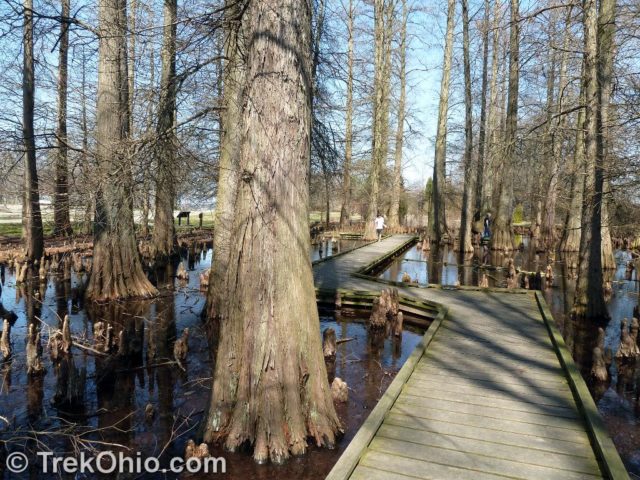
A marsh is a field that has large quantities of standing water. Marsh vegetation consists mostly of bulrushes, sedges and reeds. Here’s a marshy area that I photographed at Jackson Bog.
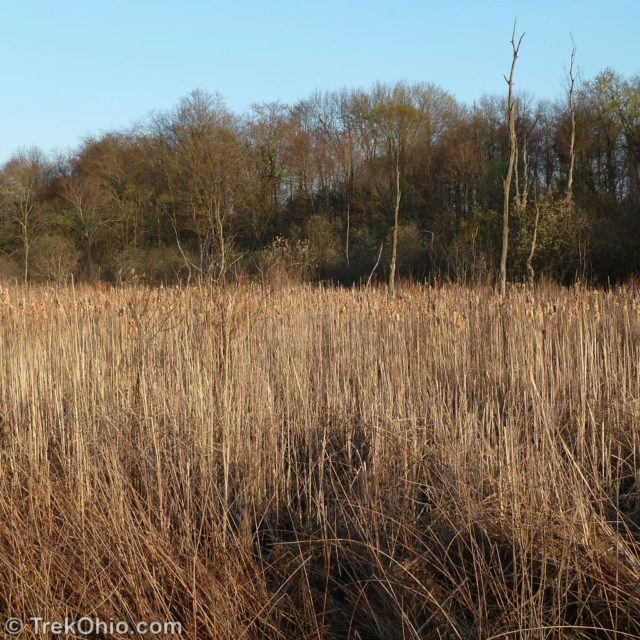
Another way of classifying wetlands is to consider what’s making the wetland wet. Either the water is seeping out of an underground aquifer in the form of a spring, or the water is falling from the sky, running downhill over the land’s surface, and finally draining into the wetland. How the water gets into the wetland will affect the water’s mineral content and acidity. If the water is seeping out of the ground, it’s going to contain a lot of dissolved minerals. If you’ve ever lived some place with hard water, you may have noticed that those dissolved minerals build up on your shower heads, tea kettles and pipes. When a wetland has a lot of dissolved minerals, the water becomes somewhat alkaline (that’s the opposite of being acidic). This alkaline, mineral-rich water may not have many other nutrients, but bulrushes and similar tall, grass-like plants are still able to thrive in it. Such a wetland is known as a fen. But wait! ![]() …that means the marsh shown in the above photo is also a fen.
…that means the marsh shown in the above photo is also a fen.
In contrast a rain-fed wetland is somewhat acidic. Low-growing mosses like sphagnum moss thrive in this kind of environment. Fresh moss often grows on top of the previous season’s dead moss. The dead moss creates an ideal environment for the living moss because the cells of the dead moss soak up water like a sponge. The water that’s stored in the dead moss will keep the living moss moist and healthy between rains. The dead moss is also buoyant, and so the dead moss helps the living moss float on the water’s surface where it gets greater exposure to sunlight and that leads to more photosynthesis. The dead moss can also make the water in the wetland become more acidic because it absorbs calcium ions from the hard water, so the water becomes less alkaline. Simultaneously the decaying moss releases hydrogen ions into the water causing the water to become more acidic (this process is called ion exchange). A wetland characterized by moss and acidic water is known as a bog.
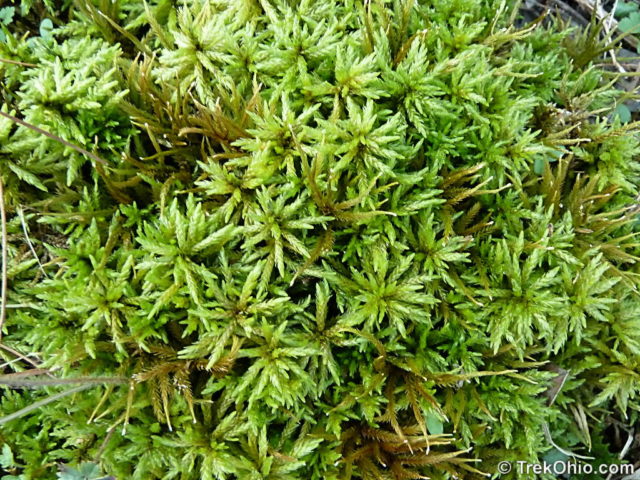
As the under-layer of dead moss slowly decays, it becomes what is known as peat. The peat stains the water brown or yellow because it releases tannin. ![]() And that might be why the water ends up looking yucky like this.
And that might be why the water ends up looking yucky like this.
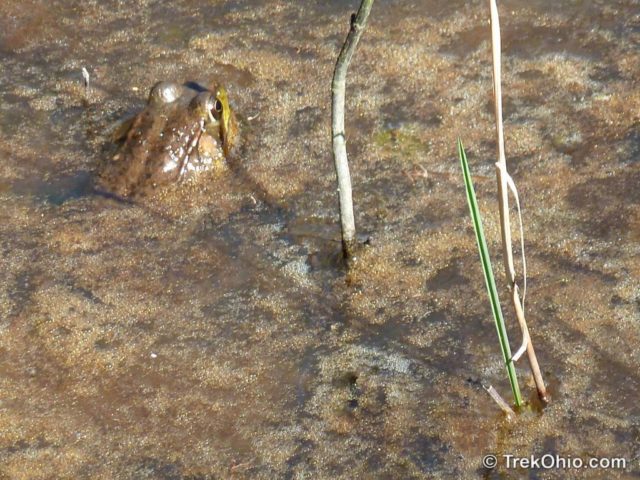
I had previously discovered that Northern Green Frogs may be brown instead of green. The brown frog above is actually a Northern “green” frog. Now I’m wondering if the brown varieties started out green, but were stained brown by their boggy habitats.
The final addition to my wetland vocabulary is the word, mire (also known as quagmire). Mire is a very wet mud. Animals that walk on mire tend to sink in deeply. In the photo below taken at Jackson Bog, you can see bird tracks all over the mire. However you’ll note that the birds sunk in sufficiently deep that their tracks didn’t leave individual toe marks. When I consider how light birds are, I can imagine that I would have sunk in quite deeply were I to have tried walking on it. Because people, animals, and vehicles can easily become stuck in mire (or quagmire) that’s why these words are used figuratively to describe getting into a situation that’s difficult to get out of.
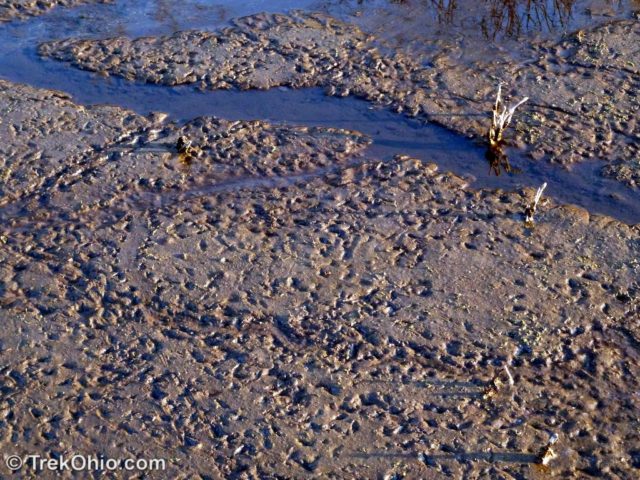
And this brings me to my final, unsolved mystery. Why is Jackson bog called a “bog” and not a “fen”? To my eye this wetland seemed to be dominated by tall, grassy vegetation. To puzzle me further, one of the informative signs at Jackson Bog said the following:
Jackson Bog was born amid a cluster of lime-rich springs found at the bottom of the hills surrounding the preserve. Plant species, usually found hundreds of miles north of here, thrive in the warming sun, rich glacial soils and plentiful water conditions too harsh for most Ohio native plants.
So Jackson Bog is an alkaline wetland that supports marsh grass. The only references to bogs that I noticed among the signs at Jackson Bog was this passage about sphagnum moss.
[Sphagnum moss] also release tremendous amounts of organic acids into their surroundings, creating islands of bog-like habitat in an otherwise alkaline fen.
And that leads me to conclude that Jackson Bog is a fen that’s interspersed with small, boggy regions. ![]() But as always, I welcome your thoughts on the matter.
But as always, I welcome your thoughts on the matter.
Additional information
- Wikipedia: Swamp
- Wikipedia: Marsh
- Wikipedia: Fen
- Wikipedia: Bog
- Wikipedia: Sphagnum moss
- Wikipedia: Peat
More on Wetlands
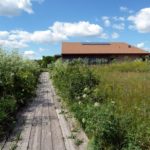
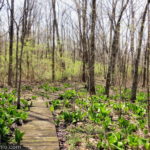
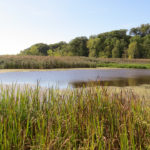
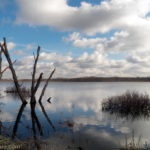
Deb, I live next to a bog and am a big fan of wetlands in general so very much enjoyed your post. There are many boardwalks in Nova Scotia. There’s a salt marsh trail in my neck of the woods which gives such a wonderful view of life in the marsh from a vantage point that’s unobstrusive to wildlife. These wet places are so full of life and such a wonder to behold.
flandrumhill (Amy-Lynn?), it made me happy to learn that you enjoyed my post. I had the pleasure of visiting Nova Scotia quite a few years ago. I didn’t get to spend a lot of time there, but I did visit Halifax and Peggy’s Cove, then I went on to Prince Edward Island. I got to explore a boardwalk on PEI that is to this day my favorite, wetland boardwalk in the world. Here’s a snapshot of the boardwalk that I scanned in from a print:
And here's a photo of myself and my daughter on the boardwalk (she's 21 y.o. now, so you can see that this is a pretty old snapshot. ):
):
I’m guessing that you have boardwalks similar to that in Nova Scotia. I’d love to get up that way again. 🙂
Deb, that’s quite a lovely boardwalk. I’ve been to PEI but have never had the pleasure of walking there. Our boardwalks are very similar. I love the sound of feet on boardwalk. They can be slippery though, especially when there’s a slight layer of saltspray and frost on them.
I’m not exactly sure when this happened, but I’m guessing it was in the 1980’s or late 70’s, but there was a recognition that fen habitat could be found in the US. Prior to this recognition, all Ohio peat lands were called bogs, regardless of their geology. So Jackson Bog and Cedar bog near Urbana were given official names of bogs rather than fens. Natural areas dedicated in the 1990’s were given the name “fen”. What complicates matters is that a botanist from further north might come to Ohio and classify all our glacial peat lands as fens. They might call our bogs “poor fens” and our fens “rich fens”. It gets complicated, and ultimately, the classification of all wetlands is purely synthetic and sometimes not entirely useful. We in the natural areas business tend to use the term “lumper” and “splitter” for those who tend to classify systems more broadly and more narrowly. Naming all glacial peatlands in Ohio “bogs” would fall on the lumper side of things, splitting into bog, fen, prairie fen, boreal fen, white cedar fen would be a “splitter” approach.
Tom Arbour, former botanist, Division of Natural Areas and Preserves
Tom, thank you for explaining why “Jackson Bog” isn’t “Jackson Fen.” It was interesting to hear that the preferred terms have changed over time.
On the other hand, the alternative nomenclature (such as “rich fens” and “poor fens”) makes it clear that some people are advocating in favor of a “fen continuum”. And it was amusing to learn of that the classifiers can be classified as lumpers and splitters.
Interesting post, thanks for sharing. I too love the boardwalk through the swamp, it’s inviting, and I’d really love to have something like that close to us to walk along quietly! 🙂
Donna, your welcome, and thank you for stopping by. You know, there’s a boardwalk within cycling distance of my home where I can go to see ospreys. There are two nesting platforms there. It’s known as a boardwalk here, but it’s really more like a pier, excepts it’s not for boats. Here’s a portion of the boardwalk during stormy weather.
The last time I went there I saw my first osprey of the season, but I just saw the one. I don’t know if its mate has returned yet.
Love that boardwalk and what a beautiful photo. It really looks as if it were painted! Thanks for sharing. We walk and bike-ride trails but few have boardwalks & they’re usually not too long over a bit of marsh and then back to pavement. I love how nature boardwalks let you see treasures otherwise seen only at a distant or not at all! 🙂
I enjoyed this informative post! I’ve been quizzing myself in order to remember it correctly…thanks for the nature info.-Susan
If you see the comment from Tom on this page, apparently the terms have changed over time, and it would appear that not all naturalists are using the same terms. Nonetheless, I feel like I’m making some progress in bettering my own understanding, and it was heartening to hear that you felt the information was helpful too. 🙂 Thanks for stopping by and for the encouraging feedback.
Very interesting. I love that photo from wooden path especially. We have similar here in Finland, but on our Arctic hills. Also the moss photo is awesome.
Happy blogging!
Thank you for your kind words about my moss photo. I’m also glad to hear that you enjoyed my post. 🙂
A number of our parks have these wooden paths (we call them “boardwalks”). I especially like the ones that are located in wet or marshy areas. However in Canada I discovered one of the longest boardwalks I’ve ever been on. The photo below is very old, but it is a picture of my daughter and myself on this boardwalk in Prince Edward Island, Canada. It was a lot of fun to go walking there.